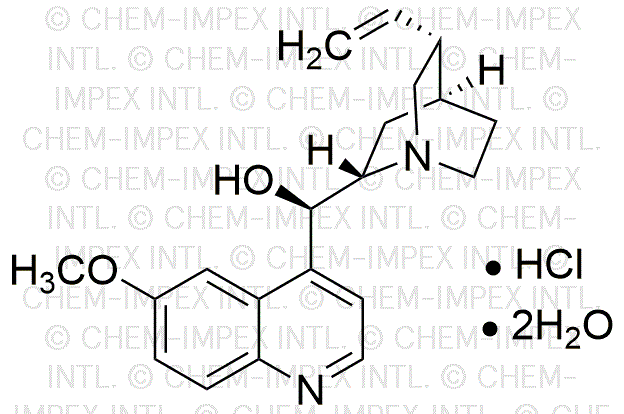Quinine hydrochloride dihydrate is widely utilized in research focused on:
- Treatment of Malaria: This compound is primarily known for its effectiveness in treating malaria, particularly in areas where resistance to other antimalarial drugs has developed. Its unique mechanism of action makes it a valuable option in combating this disease.
- Pharmaceutical Development: Researchers use quinine hydrochloride dihydrate in the development of new antimalarial medications. Its established efficacy provides a benchmark for testing new compounds in clinical trials.
- Flavoring Agent: In the beverage industry, this compound is used as a flavoring agent in tonic water and other drinks. Its distinct bitter taste is sought after by consumers, making it a popular choice for enhancing beverage profiles.
- Research on Pain Relief: Quinine hydrochloride dihydrate is also studied for its analgesic properties. It has been investigated as a potential treatment for certain types of pain, providing an alternative for patients who may not respond to conventional pain relievers.
- Veterinary Medicine: The compound finds applications in veterinary medicine, particularly for treating parasitic infections in animals. Its use in this field helps improve animal health and productivity in agricultural settings.
General Information
Properties
Safety and Regulations
Applications
Quinine hydrochloride dihydrate is widely utilized in research focused on:
- Treatment of Malaria: This compound is primarily known for its effectiveness in treating malaria, particularly in areas where resistance to other antimalarial drugs has developed. Its unique mechanism of action makes it a valuable option in combating this disease.
- Pharmaceutical Development: Researchers use quinine hydrochloride dihydrate in the development of new antimalarial medications. Its established efficacy provides a benchmark for testing new compounds in clinical trials.
- Flavoring Agent: In the beverage industry, this compound is used as a flavoring agent in tonic water and other drinks. Its distinct bitter taste is sought after by consumers, making it a popular choice for enhancing beverage profiles.
- Research on Pain Relief: Quinine hydrochloride dihydrate is also studied for its analgesic properties. It has been investigated as a potential treatment for certain types of pain, providing an alternative for patients who may not respond to conventional pain relievers.
- Veterinary Medicine: The compound finds applications in veterinary medicine, particularly for treating parasitic infections in animals. Its use in this field helps improve animal health and productivity in agricultural settings.
Documents
Safety Data Sheets (SDS)
The SDS provides comprehensive safety information on handling, storage, and disposal of the product.
Product Specification (PS)
The PS provides a comprehensive breakdown of the product’s properties, including chemical composition, physical state, purity, and storage requirements. It also details acceptable quality ranges and the product's intended applications.
Certificates of Analysis (COA)
Search for Certificates of Analysis (COA) by entering the products Lot Number. Lot and Batch Numbers can be found on a product’s label following the words ‘Lot’ or ‘Batch’.
*Catalog Number
*Lot Number
Certificates Of Origin (COO)
This COO confirms the country where the product was manufactured, and also details the materials and components used in it and whether it is derived from natural, synthetic, or other specific sources. This certificate may be required for customs, trade, and regulatory compliance.
*Catalog Number
*Lot Number
Safety Data Sheets (SDS)
The SDS provides comprehensive safety information on handling, storage, and disposal of the product.
DownloadProduct Specification (PS)
The PS provides a comprehensive breakdown of the product’s properties, including chemical composition, physical state, purity, and storage requirements. It also details acceptable quality ranges and the product's intended applications.
DownloadCertificates of Analysis (COA)
Search for Certificates of Analysis (COA) by entering the products Lot Number. Lot and Batch Numbers can be found on a product’s label following the words ‘Lot’ or ‘Batch’.
*Catalog Number
*Lot Number
Certificates Of Origin (COO)
This COO confirms the country where the product was manufactured, and also details the materials and components used in it and whether it is derived from natural, synthetic, or other specific sources. This certificate may be required for customs, trade, and regulatory compliance.


